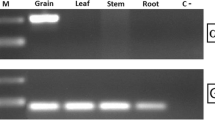Abstract
Caffeine (1,3,7-trimethylxanthine) is derived from xanthosine through three successive transfers of methyl groups and a single ribose removal in coffee plants. The methyl group transfer is catalyzed by N-zmethyltransferases, xanthosine methyltransferase (XMT), 7-methylxanthine methyltransferase (MXMT) and 3,7-dimethylxanthine methyltransferase (DXMT). We previously cloned three genes encoding each of these N-methyltransferases from coffee plants, and reconstituted the final sequence of the caffeine synthetic pathway in vitro. In the present study, we simultaneously expressed these coffee genes in tobacco plants (Nicotiana tabacum), using a multiple-gene transfer method, and confirmed successful caffeine production up to 5 μg g−1 fresh weight in leaves of the resulting transgenic plants. Their effects on feeding behavior of tobacco cutworms (Spodoptera litura), which damage a wide range of crops, were then examined. Leaf disc choice test showed that caterpillars selectively fed on the wild-type control materials, or positively avoided the transgenic materials. The results suggest a novel approach to confer self-defense by producing caffeine in planta. A second generation of transgenic crops containing caffeine may save labor and agricultural costs and also mitigate the environmental load of pesticides in future.
Similar content being viewed by others
References
R.J. Aerts V. Luca ParticleDe (1992) ArticleTitlePhytochrome is involved in the light-regulation of vindoline biosynthesis in Catharanthus Plant Physiol. 100 1029–1032
H. Ashihara A. Crozier (1999) ArticleTitleBiosynthesis and metabolism of caffeine and related purine alkaloids in plants Adv. Bot. Res. 30 118–205
H. Ashihara A. Crozier (2001) ArticleTitleCaffeine: a well known but little mentioned compound in plant science Trends Plant Sci. 6 407–413 Occurrence Handle10.1016/S1360-1385(01)02055-6 Occurrence Handle11544129
T.W. Baumann B.H. Schulthess K. Hänni (1995) ArticleTitleGuaraná (Paullinia cupana) rewards seed dispersers without intoxicating them by caffeine Phytochemistry 39 1063–1070 Occurrence Handle10.1016/0031-9422(94)00141-F
R. Croteau T.M. Kutchan N.G. Lews (2000) Natural products (Secondary metabolites) B.B. Buchanan W. Gruissem R.L. Jones (Eds) Biochemistry and Molecular Biology of Plants American Society of Plant Physiologists Rockville 1250–1318
Y. Hiei S. Ohta T. Komari T. Kumashiro (1994) ArticleTitleEfficient transformation of rice (Oryza sativa L.) mediated by Agrobacterium and sequence analysis of the boundaries of the T-DNA Plant J. 6 271–282 Occurrence Handle10.1046/j.1365-313X.1994.6020271.x Occurrence Handle7920717
R.G. Hollingsworth J.W. Armstrong E. Campbell (2002) ArticleTitleCaffeine as a repellent for slugs and snails: at high concentrations this stimulant becomes a lethal neurotoxin to garden pests Nature 417 915–916 Occurrence Handle10.1038/417915a Occurrence Handle12087394
M. Kato K. Mizuno A. Crozier T. Fujimura H. Ashihara (2000) ArticleTitleCaffeine synthase gene from tea leaves Nature 406 956–957 Occurrence Handle10.1038/35023072 Occurrence Handle10984041
S. Mathavan Y. Premalatha M.S.M. Christopher (1985) ArticleTitleEffects of caffeine and theophylline on the fecundity of four lepidopteran species Exp. Biol. 44 133–138 Occurrence Handle3850026
K. Mizuno A. Okuda M. Kato N. Yoneyama H. Tanaka H. Ashihara T. Fujimura (2003) ArticleTitleIsolation of a new dual-functional caffeine synthase gene encoding an enzyme for the conversion of 7-methylxanthine to caffeine from coffee (Coffea arabica L.) FEBS Lett. 534 75–81 Occurrence Handle10.1016/S0014-5793(02)03781-X Occurrence Handle12527364
S.S. Mosli Waldhauser T.W. Baumann (1996) ArticleTitleCompartmentation of caffeine and related purine alkaloids depends exclusively on the physical chemistry of their vacuolar complex formation with chlorogenic acids Phytochemistry 42 985–996 Occurrence Handle10.1016/0031-9422(96)00072-6
J.A. Nathanson (1984) ArticleTitleCaffeine and related methylxanthines: possible naturally occurring pesticides Science 226 184–187 Occurrence Handle6207592
M. Ogawa Y. Herai N. Koizumi T. Kusano H. Sano (2001) ArticleTitle7-Methylxanthine methyltransferase of coffee plants: gene isolation and enzymatic properties J. Biol. Chem. 276 8213–8218 Occurrence Handle10.1074/jbc.M009480200 Occurrence Handle11108716
T. Schmeller M. Wink (1998) Utilization of alkaloids in modern medicine M.F. Roberts M. Wink (Eds) Alkaloids: Biochemistry, Ecology, and Medicinal Applications Prenum Press New York 435–459
C. Seeger C. Poulsen G. Dandanell (1995) ArticleTitleIdentification and characterization of genes (xapA, xapB, and xapR) involved in xanthosine catabolism in Escherichia coli J. Bacteriol. 177 5506–5516 Occurrence Handle7559336
C. Stasolla R. Katahira T.A. Thorpe H. Ashihara (2003) ArticleTitlePurine and pyrimidine nucleotide metabolism in higher plants J. Plant Physiol. 160 1271–1295 Occurrence Handle10.1078/0176-1617-01169 Occurrence Handle14658380
H. Uefuji S. Ogita Y. Yamaguchi N. Koizumi H. Sano (2003) ArticleTitleMolecular cloning and functional characterization of three distinct N-methyltransferases involved in the caffeine biosynthetic pathway in coffee plants Plant Physiol. 132 372–380 Occurrence Handle10.1104/pp.102.019679 Occurrence Handle12746542
US Code of Federal Regulations 2001. Title 21-Food and Drugs (21CFR182), US Government, p. 455
B.F. Usher E.A. Bernays R.V. Barbehenn (1988) ArticleTitleAntifeedant tests with larvae of Pseudaletia unipuncta: viability of behavioral response Entomol. Exp. Appl. 48 203–212 Occurrence Handle10.1007/BF00376399
Author information
Authors and Affiliations
Corresponding author
Rights and permissions
About this article
Cite this article
Uefuji, H., Tatsumi, Y., Morimoto, M. et al. Caffeine Production in Tobacco Plants by Simultaneous Expression of Three Coffee N-methyltrasferases and Its Potential as a Pest Repellant. Plant Mol Biol 59, 221–227 (2005). https://doi.org/10.1007/s11103-005-8520-x
Received:
Accepted:
Issue Date:
DOI: https://doi.org/10.1007/s11103-005-8520-x




